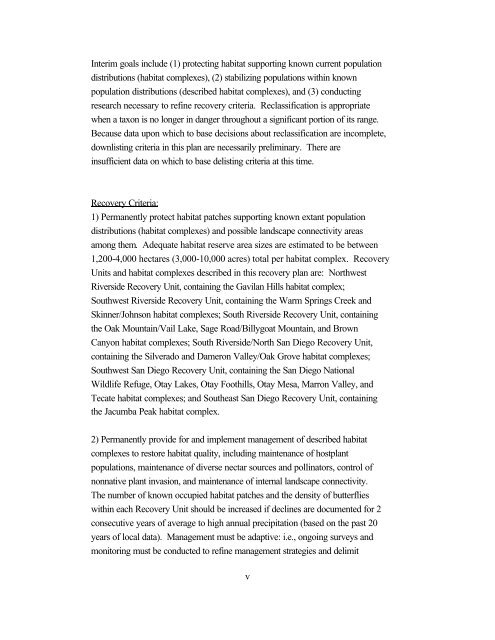Outline of Quino Recovery Plan - The Xerces Society
Outline of Quino Recovery Plan - The Xerces Society
Outline of Quino Recovery Plan - The Xerces Society
You also want an ePaper? Increase the reach of your titles
YUMPU automatically turns print PDFs into web optimized ePapers that Google loves.
Interim goals include (1) protecting habitat supporting known current population<br />
distributions (habitat complexes), (2) stabilizing populations within known<br />
population distributions (described habitat complexes), and (3) conducting<br />
research necessary to refine recovery criteria. Reclassification is appropriate<br />
when a taxon is no longer in danger throughout a significant portion <strong>of</strong> its range.<br />
Because data upon which to base decisions about reclassification are incomplete,<br />
downlisting criteria in this plan are necessarily preliminary. <strong>The</strong>re are<br />
insufficient data on which to base delisting criteria at this time.<br />
<strong>Recovery</strong> Criteria:<br />
1) Permanently protect habitat patches supporting known extant population<br />
distributions (habitat complexes) and possible landscape connectivity areas<br />
among them. Adequate habitat reserve area sizes are estimated to be between<br />
1,200-4,000 hectares (3,000-10,000 acres) total per habitat complex. <strong>Recovery</strong><br />
Units and habitat complexes described in this recovery plan are: Northwest<br />
Riverside <strong>Recovery</strong> Unit, containing the Gavilan Hills habitat complex;<br />
Southwest Riverside <strong>Recovery</strong> Unit, containing the Warm Springs Creek and<br />
Skinner/Johnson habitat complexes; South Riverside <strong>Recovery</strong> Unit, containing<br />
the Oak Mountain/Vail Lake, Sage Road/Billygoat Mountain, and Brown<br />
Canyon habitat complexes; South Riverside/North San Diego <strong>Recovery</strong> Unit,<br />
containing the Silverado and Dameron Valley/Oak Grove habitat complexes;<br />
Southwest San Diego <strong>Recovery</strong> Unit, containing the San Diego National<br />
Wildlife Refuge, Otay Lakes, Otay Foothills, Otay Mesa, Marron Valley, and<br />
Tecate habitat complexes; and Southeast San Diego <strong>Recovery</strong> Unit, containing<br />
the Jacumba Peak habitat complex.<br />
2) Permanently provide for and implement management <strong>of</strong> described habitat<br />
complexes to restore habitat quality, including maintenance <strong>of</strong> hostplant<br />
populations, maintenance <strong>of</strong> diverse nectar sources and pollinators, control <strong>of</strong><br />
nonnative plant invasion, and maintenance <strong>of</strong> internal landscape connectivity.<br />
<strong>The</strong> number <strong>of</strong> known occupied habitat patches and the density <strong>of</strong> butterflies<br />
within each <strong>Recovery</strong> Unit should be increased if declines are documented for 2<br />
consecutive years <strong>of</strong> average to high annual precipitation (based on the past 20<br />
years <strong>of</strong> local data). Management must be adaptive: i.e., ongoing surveys and<br />
monitoring must be conducted to refine management strategies and delimit<br />
v
















